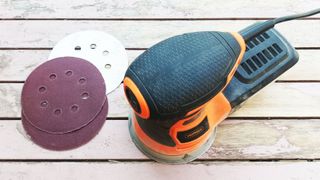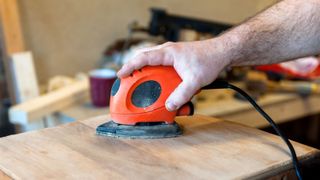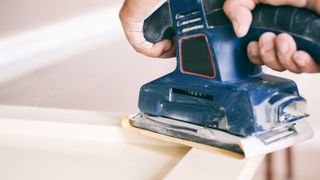Types of sander: Which do you need for your DIY projects?
Need a new sander? With so many different types of sander it's not always easy to choose the right one. Here we help you decide what you need

Self builders and DIYers all need a sander, but which types of sander should you consider to get the job done? Choosing the right sander is essential if you want to finish a project properly.
You don’t want to be investing in a floor sander if sanding skirting boards, but the difference in sanders isn’t always this obvious. Should you get a detail sander or orbital sander for sanding doors or windows? What about newly plastered walls? Can I use different sanders for the same job? Here we guide you through the popular types of sanders and which works best for what.
Types of sander: What are they and what do they do?
Here we delve into the different sanders that you might need for your projects. From the best orbital sanders to floor sanders, hand sanders and more.
Orbital sander
Also known as random orbital sanders, they are one of the most popular choices for DIYers thanks to their versatility. They have a round pad that spins and oscillates at the same time in an ellipse pattern. This helps produce a smooth finish and eliminate sanding marks from a surface. They use a hook and loop system – which is like velcro – to attach sanding discs.
Their shape and finish makes them a good choice for a wide range of sanding projects including removing paint and sanding wood in preparation for painting, sanding MDF and any flat surfaces and edges.
Check out our How to use an orbital sander guide to get a deep dive into the best way to use one.
Detail sander
Details sanders are small hand sanders that have a triangular shape pad that gives it a point so that it can get into corners or narrow areas. Their sanding discs are typically one piece with holes like these Universal Fit Assorted Punched Sanding sheet set from B&Q. The holes help direct dust into the dust bag for collection.
Their small size also makes them ideal for sanding stair treads and risers, spindles and bannisters, chair legs, skirting boards, panel doors and furniture.

Belt sander
Belt sanders are powerful sanders that run a continuous sanding belt around a pair of drum wheels. They are typically portable though they are often paired with a disc sander that is fixed to a bench.
They are a good choice for heavy duty sanding tasks. They rapidly remove material such as paint and are excellent for smoothing out rough timber and taking off fine layers quickly. They are great for large flat surfaces like doors or panels and due to their design they are good for shaping wood.
Sheet sander
Sheets sanders are similar to orbital sanders, but instead of a round pad they have a square or rectangular pad. The pad has a back and forth circular action that makes them good for smaller scale sanding jobs or finishing jobs. However, they are more likely to leave marks compared with an orbital sander, but the difference is negligible.
Their shape makes them a great choice for getting into corners and ideal for sanding stairs, sanding doors – especially panel doors, other small flat areas and sanding between coats of paint or varnish. They are not a good choice for removing a lot of material.

Floor sander
The term floor sander commonly refers to a large upright sander that’s used for sanding floorboards. These typically have a large drum that rotates at high speed to quickly take off the surface and imperfections on hardwood floors and floor boards, ready for varnishing or waxing.
They are used in combination with an edging sander to get a full wall to wall finish. Alternatively, you can use an orbital sander for the edges of a room, but this will typically take longer.
Floor sanders are expensive to buy and are rarely used more than a few times, so hiring one is the popular choice. Expect to pay around £40-£50 for 24 hours for a floor sander and around £50-£70 for floor and edge sander hire.
Drywall sander
Drywall sanders are sanders specifically designed for smoothing down newly plastered walls or ceilings ready for another layer, a coat of paint and flattening joins or repairs. Handheld versions have two handles and a round sanding disc like an orbital sander but larger and variable speeds. The large pad helps to ensure that you get a smooth flat surface on a wall or ceiling.
Long handled drywall sanders like the MYTOL Drywall Sander from Amazon - also known as Giraffe sanders – do the same job, but are more convenient, making it easier to reach ceilings and tops of walls.
Hand sander
A hand sander is very much what its name suggests, it is a sander powered by hand. They typically have a hand grip and a flat surface like the Stanley Hand Sander from Amazon to which you attach your sandpaper.
This makes it ideal for most sanding jobs including large flat areas and especially useful if not near a power point. They are cheaper than a power sander, but you will need plenty of muscle power, so they are typically used in short bursts.
A variation on the hand sander is a pole sander like the ProDec Heavy Duty Swivel Pole Sander Head which is attached to a pole making it useful for sanding walls and ceilings – before painting or hanging wallpaper – without the need for a ladder.
Belt & Disc sander
A belt & disc sander like the SKIL Belt and Disc Combination Benchtop Sander from Amazon brings together two types of sander in one machine. As you might expect you get a disc sander which typically has a vertical sanding pad and a table stabilising the wood and an angle plate for consistent end grain work.
The belt sander is typically flat, but in some cases it may be vertical. It also has a table and is good for flattening/levelling long edges and adding bevelled edges.
It’s not a portable sander like an orbital or detail sander, it is typically attached to a workbench or similar. It's not a tool for everyday DIY sanding projects, but ideal if you are a woodwork enthusiast.
What sander should I buy first?
This depends very much on what projects you are going to be working on, but if you are looking for a general purpose power sander we recommend starting out with an orbital sander, you can read more about 'what is an orbital sander?' in our guide.
They are versatile, easy to use and good for a whole host of sanding projects including sanding doors, windows, skirting boards, walls and furniture. Their round sanding pad helps produce a smooth finish that offers less sanding marks than other power sanders.
However, if you need a sander for slightly more intricate work such as sanding corners a detail sander such as the BLACK+DECKER 55 W Detail Mouse Electric Sander from Amazon is an inexpensive choice. They can be used to perform the same tasks as an orbital sander, but ideally you should have both in your collection.
Get the Homebuilding & Renovating Newsletter
Bring your dream home to life with expert advice, how to guides and design inspiration. Sign up for our newsletter and get two free tickets to a Homebuilding & Renovating Show near you.
Steve Jenkins is a freelance content creator with over two decades of experience working in digital and print and was previously the DIY content editor for Homebuilding & Renovating.
He is a keen DIYer with over 20 years of experience in transforming and renovating the many homes he has lived in. He specialises in painting and decorating, but has a wide range of skills gleaned from working in the building trade for around 10 years and spending time at night school learning how to plaster and plumb.
He has fitted kitchens, tiled bathrooms and kitchens, laid many floors, built partition walls, plastered walls, plumbed in bathrooms, worked on loft conversions and much more. And when he's not sure how to tackle a DIY project he has a wide network of friends – including plumbers, gas engineers, tilers, carpenters, painters and decorators, electricians and builders – in the trade to call upon.
